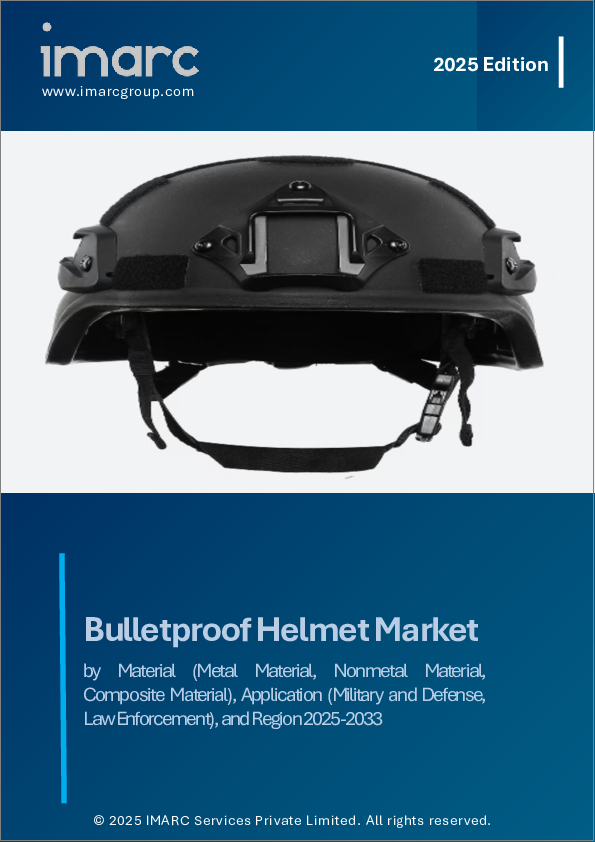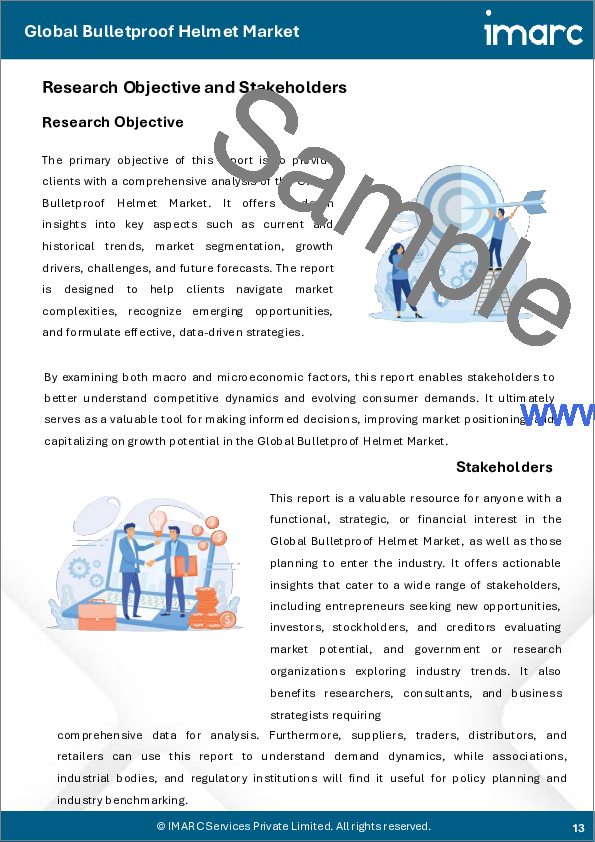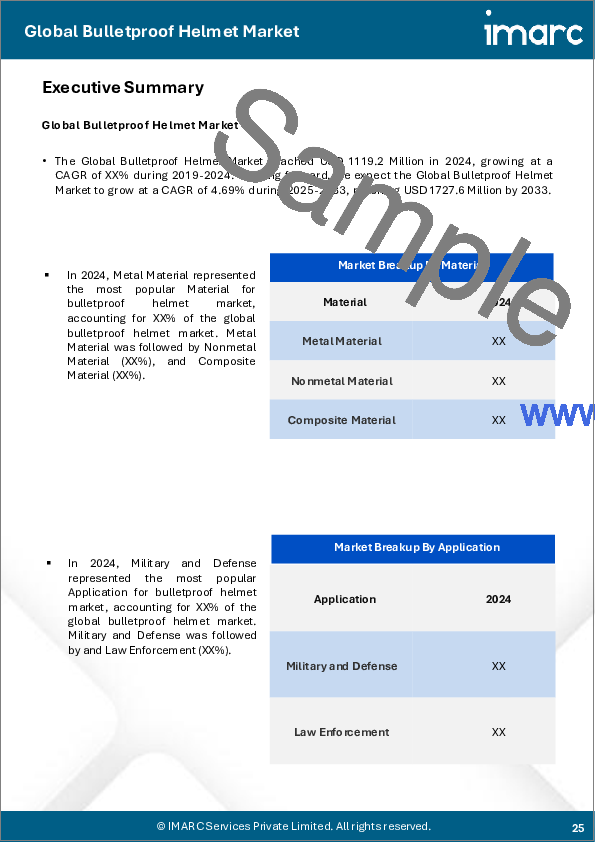|
|
市場調査レポート
商品コード
1636372
防弾ヘルメット市場:材料別、用途別、地域別、2025-2033年Bulletproof Helmet Market by Material (Metal Material, Nonmetal Material, Composite Material), Application (Military and Defense, Law Enforcement), and Region 2025-2033 |
||||||
カスタマイズ可能
|
|||||||
| 防弾ヘルメット市場:材料別、用途別、地域別、2025-2033年 |
|
出版日: 2025年01月10日
発行: IMARC
ページ情報: 英文 135 Pages
納期: 2~3営業日
|
全表示
- 概要
- 図表
- 目次
防弾ヘルメット市場の世界市場規模は2024年に11億1,920万米ドルに達しました。今後、IMARC Groupは、市場は2033年までに17億2,760万米ドルに達し、2025年から2033年にかけて4.69%の成長率(CAGR)を示すと予測しています。秩序違反、内部問題、反乱の増加、軍事兵器と戦争資産のアップグレードのための国防予算の大幅な増加、防弾ヘルメットの製造における軽量材料の使用の増加は、市場を牽引する主な要因のいくつかを表しています。
防弾ヘルメットは弾道ヘルメットとも呼ばれ、戦闘中に榴散弾、銃弾、破片から頭部を保護するように設計された軍用ヘルメットを指します。防弾ヘルメットは、すべての軍隊や警察官にとって必要不可欠なものであり、潜在的に危険な要素、特に弾道の脅威、破片や空気中の飛散粒子から身を守るために使用されます。既存のNVG銃や通信機器との互換性に加え、これらの防弾ヘルメットには核、生物、化学の防衛機器を取り付けることもできます。防弾ヘルメットは多くの場合、ケブラーやトワロンのような防弾材料から作られており、極端な温度、火災、水、湿気、紫外線(UV)に対する保護が強化されています。保持力を高めるため、これらのヘルメットにはパッドサスペンション、調整スライド、耐衝撃性ハードウェアが装備されています。高い破断強度と頑丈な材料は、銃撃からの保護を強化するだけでなく、戦場での負傷率を低下させるとともに、戦闘の有効性と生存性を高めます。
防弾ヘルメット市場動向:
さまざまな政府による対テロ活動のための安全対策が増加していることが、市場を牽引する重要な要因となっています。この背景には、国境を越えた侵害、内部問題、反乱の世界の蔓延があります。これに伴い、銃弾や鋭利な武器による頭部の損傷から兵士や法執行官を保護することに重点が置かれるようになり、市場にプラスの影響を与えています。さらに、軍事兵器と戦争資産のアップグレードのための防衛予算の増加は、より高い製品の取り込みをもたらします。さらに、装甲システムの効率を高めるために、メーカーによるアラミド繊維やポリマーなどの軽量材料の使用が増加していることも、市場に弾みをつけています。これに加えて、ナノテクノロジー、拡張現実(AR)センサーやカメラの使用、ヘルメット装着型HUDバイザーなどの継続的な製品革新が、市場に有利な成長機会を生み出しています。この市場は、国家軍事基地の拡大、兵器試験活動の増加、世界レベルでの軍事近代化の高まりによってさらに推進されています。市場の見通しを好転させるその他の要因としては、地政学的緊張の高まり、兵士保護に関する意識の高まり、数々の技術的進歩、主要企業による広範な研究開発(R&D)活動などが挙げられます。
本レポートで扱う主な質問
- 2024年の世界の防弾ヘルメット市場の市場規模は?
- 2025-2033年における世界の防弾ヘルメット市場の予想成長率は?
- 世界の防弾ヘルメット市場を牽引する主要因は何か?
- 世界の防弾ヘルメット市場に対するCOVID-19の影響は?
- 世界の防弾ヘルメット市場の材料別内訳は?
- 世界の防弾ヘルメット市場の用途別内訳は?
- 世界の防弾ヘルメット市場の主要地域は?
- 世界の防弾ヘルメット市場における主要プレイヤー/企業は?
目次
第1章 序文
第2章 調査範囲と調査手法
- 調査の目的
- ステークホルダー
- データソース
- 一次情報
- 二次情報
- 市場推定
- ボトムアップアプローチ
- トップダウンアプローチ
- 調査手法
第3章 エグゼクティブサマリー
第4章 イントロダクション
- 概要
- 主要業界動向
第5章 世界の防弾ヘルメット市場
- 市場概要
- 市場実績
- COVID-19の影響
- 市場予測
第6章 市場内訳:材料別
- 金属材料
- 市場動向
- 市場予測
- 非金属材料
- 市場動向
- 市場予測
- 複合材料
- 市場動向
- 市場予測
第7章 市場内訳:用途別
- 軍事・防衛
- 市場動向
- 市場予測
- 法執行機関
- 市場動向
- 市場予測
第8章 市場内訳:地域別
- 北米
- 米国
- カナダ
- アジア太平洋地域
- 中国
- 日本
- インド
- 韓国
- オーストラリア
- インドネシア
- その他
- 欧州
- ドイツ
- フランス
- 英国
- イタリア
- スペイン
- ロシア
- その他
- ラテンアメリカ
- ブラジル
- メキシコ
- その他
- 中東・アフリカ
第9章 促進要因・抑制要因・機会
- 概要
- 促進要因
- 抑制要因
- 機会
第10章 バリューチェーン分析
第11章 ポーターのファイブフォース分析
- 概要
- 買い手の交渉力
- 供給企業の交渉力
- 競合の程度
- 新規参入業者の脅威
- 代替品の脅威
第12章 価格分析
第13章 競合情勢
- 市場構造
- 主要企業
- 主要企業のプロファイル
- Argun s.r.o.
- ArmorSource LLC
- Avon Protection plc
- Hard Shell FZE
- MKU Limited(GKG Group)
- Point Blank Enterprises Inc.
- Protection Group Danmark
- Sinoarmor
- Ulbrichts GmbH
List of Figures
- Figure 1: Global: Bulletproof Helmet Market: Major Drivers and Challenges
- Figure 2: Global: Bulletproof Helmet Market: Sales Value (in Million USD), 2019-2024
- Figure 3: Global: Bulletproof Helmet Market Forecast: Sales Value (in Million USD), 2025-2033
- Figure 4: Global: Bulletproof Helmet Market: Breakup by Material (in %), 2024
- Figure 5: Global: Bulletproof Helmet Market: Breakup by Application (in %), 2024
- Figure 6: Global: Bulletproof Helmet Market: Breakup by Region (in %), 2024
- Figure 7: Global: Bulletproof Helmet (Metal Material) Market: Sales Value (in Million USD), 2019 & 2024
- Figure 8: Global: Bulletproof Helmet (Metal Material) Market Forecast: Sales Value (in Million USD), 2025-2033
- Figure 9: Global: Bulletproof Helmet (Nonmetal Material) Market: Sales Value (in Million USD), 2019 & 2024
- Figure 10: Global: Bulletproof Helmet (Nonmetal Material) Market Forecast: Sales Value (in Million USD), 2025-2033
- Figure 11: Global: Bulletproof Helmet (Composite Material) Market: Sales Value (in Million USD), 2019 & 2024
- Figure 12: Global: Bulletproof Helmet (Composite Material) Market Forecast: Sales Value (in Million USD), 2025-2033
- Figure 13: Global: Bulletproof Helmet (Military and Defense) Market: Sales Value (in Million USD), 2019 & 2024
- Figure 14: Global: Bulletproof Helmet (Military and Defense) Market Forecast: Sales Value (in Million USD), 2025-2033
- Figure 15: Global: Bulletproof Helmet (Law Enforcement) Market: Sales Value (in Million USD), 2019 & 2024
- Figure 16: Global: Bulletproof Helmet (Law Enforcement) Market Forecast: Sales Value (in Million USD), 2025-2033
- Figure 17: North America: Bulletproof Helmet Market: Sales Value (in Million USD), 2019 & 2024
- Figure 18: North America: Bulletproof Helmet Market Forecast: Sales Value (in Million USD), 2025-2033
- Figure 19: United States: Bulletproof Helmet Market: Sales Value (in Million USD), 2019 & 2024
- Figure 20: United States: Bulletproof Helmet Market Forecast: Sales Value (in Million USD), 2025-2033
- Figure 21: Canada: Bulletproof Helmet Market: Sales Value (in Million USD), 2019 & 2024
- Figure 22: Canada: Bulletproof Helmet Market Forecast: Sales Value (in Million USD), 2025-2033
- Figure 23: Asia-Pacific: Bulletproof Helmet Market: Sales Value (in Million USD), 2019 & 2024
- Figure 24: Asia-Pacific: Bulletproof Helmet Market Forecast: Sales Value (in Million USD), 2025-2033
- Figure 25: China: Bulletproof Helmet Market: Sales Value (in Million USD), 2019 & 2024
- Figure 26: China: Bulletproof Helmet Market Forecast: Sales Value (in Million USD), 2025-2033
- Figure 27: Japan: Bulletproof Helmet Market: Sales Value (in Million USD), 2019 & 2024
- Figure 28: Japan: Bulletproof Helmet Market Forecast: Sales Value (in Million USD), 2025-2033
- Figure 29: India: Bulletproof Helmet Market: Sales Value (in Million USD), 2019 & 2024
- Figure 30: India: Bulletproof Helmet Market Forecast: Sales Value (in Million USD), 2025-2033
- Figure 31: South Korea: Bulletproof Helmet Market: Sales Value (in Million USD), 2019 & 2024
- Figure 32: South Korea: Bulletproof Helmet Market Forecast: Sales Value (in Million USD), 2025-2033
- Figure 33: Australia: Bulletproof Helmet Market: Sales Value (in Million USD), 2019 & 2024
- Figure 34: Australia: Bulletproof Helmet Market Forecast: Sales Value (in Million USD), 2025-2033
- Figure 35: Indonesia: Bulletproof Helmet Market: Sales Value (in Million USD), 2019 & 2024
- Figure 36: Indonesia: Bulletproof Helmet Market Forecast: Sales Value (in Million USD), 2025-2033
- Figure 37: Others: Bulletproof Helmet Market: Sales Value (in Million USD), 2019 & 2024
- Figure 38: Others: Bulletproof Helmet Market Forecast: Sales Value (in Million USD), 2025-2033
- Figure 39: Europe: Bulletproof Helmet Market: Sales Value (in Million USD), 2019 & 2024
- Figure 40: Europe: Bulletproof Helmet Market Forecast: Sales Value (in Million USD), 2025-2033
- Figure 41: Germany: Bulletproof Helmet Market: Sales Value (in Million USD), 2019 & 2024
- Figure 42: Germany: Bulletproof Helmet Market Forecast: Sales Value (in Million USD), 2025-2033
- Figure 43: France: Bulletproof Helmet Market: Sales Value (in Million USD), 2019 & 2024
- Figure 44: France: Bulletproof Helmet Market Forecast: Sales Value (in Million USD), 2025-2033
- Figure 45: United Kingdom: Bulletproof Helmet Market: Sales Value (in Million USD), 2019 & 2024
- Figure 46: United Kingdom: Bulletproof Helmet Market Forecast: Sales Value (in Million USD), 2025-2033
- Figure 47: Italy: Bulletproof Helmet Market: Sales Value (in Million USD), 2019 & 2024
- Figure 48: Italy: Bulletproof Helmet Market Forecast: Sales Value (in Million USD), 2025-2033
- Figure 49: Spain: Bulletproof Helmet Market: Sales Value (in Million USD), 2019 & 2024
- Figure 50: Spain: Bulletproof Helmet Market Forecast: Sales Value (in Million USD), 2025-2033
- Figure 51: Russia: Bulletproof Helmet Market: Sales Value (in Million USD), 2019 & 2024
- Figure 52: Russia: Bulletproof Helmet Market Forecast: Sales Value (in Million USD), 2025-2033
- Figure 53: Others: Bulletproof Helmet Market: Sales Value (in Million USD), 2019 & 2024
- Figure 54: Others: Bulletproof Helmet Market Forecast: Sales Value (in Million USD), 2025-2033
- Figure 55: Latin America: Bulletproof Helmet Market: Sales Value (in Million USD), 2019 & 2024
- Figure 56: Latin America: Bulletproof Helmet Market Forecast: Sales Value (in Million USD), 2025-2033
- Figure 57: Brazil: Bulletproof Helmet Market: Sales Value (in Million USD), 2019 & 2024
- Figure 58: Brazil: Bulletproof Helmet Market Forecast: Sales Value (in Million USD), 2025-2033
- Figure 59: Mexico: Bulletproof Helmet Market: Sales Value (in Million USD), 2019 & 2024
- Figure 60: Mexico: Bulletproof Helmet Market Forecast: Sales Value (in Million USD), 2025-2033
- Figure 61: Others: Bulletproof Helmet Market: Sales Value (in Million USD), 2019 & 2024
- Figure 62: Others: Bulletproof Helmet Market Forecast: Sales Value (in Million USD), 2025-2033
- Figure 63: Middle East and Africa: Bulletproof Helmet Market: Sales Value (in Million USD), 2019 & 2024
- Figure 64: Middle East and Africa: Bulletproof Helmet Market: Breakup by Country (in %), 2024
- Figure 65: Middle East and Africa: Bulletproof Helmet Market Forecast: Sales Value (in Million USD), 2025-2033
- Figure 66: Global: Bulletproof Helmet Industry: Drivers, Restraints, and Opportunities
- Figure 67: Global: Bulletproof Helmet Industry: Value Chain Analysis
- Figure 68: Global: Bulletproof Helmet Industry: Porter's Five Forces Analysis
List of Tables
- Table 1: Global: Bulletproof Helmet Market: Key Industry Highlights, 2024 & 2033
- Table 2: Global: Bulletproof Helmet Market Forecast: Breakup by Material (in Million USD), 2025-2033
- Table 3: Global: Bulletproof Helmet Market Forecast: Breakup by Application (in Million USD), 2025-2033
- Table 4: Global: Bulletproof Helmet Market Forecast: Breakup by Region (in Million USD), 2025-2033
- Table 5: Global: Bulletproof Helmet Market: Competitive Structure
- Table 6: Global: Bulletproof Helmet Market: Key Players
The global bulletproof helmet market size reached USD 1,119.2 Million in 2024. Looking forward, IMARC Group expects the market to reach USD 1,727.6 Million by 2033, exhibiting a growth rate (CAGR) of 4.69% during 2025-2033. The rising prevalence of cross-order breaches, internal issues, and insurgencies, a considerable rise in the defense budget for the upgradation of military weaponry and war assets, and the increasing use of lightweight materials in the manufacturing of bulletproof helmets represent some of the key factors driving the market.
Bulletproof helmets, also known as ballistic helmets, refers to military helmets designed to protect the head from shrapnel, bullets, and fragmented particles during combat. Bulletproof helmets are essential for all armed forces and police personnel, who use them for protection against potentially hazardous elements, particularly ballistic threats, and fragments and airborne flying particles. In addition to being compatible with existing NVG guns and communications, these bullet-resistant helmets can also be fitted with nuclear, biological, and chemical defense equipment. Bulletproof helmets often are made from ballistic materials like kevlar and twaron, which provide enhanced protection against extreme temperatures, fires, water, moisture, and ultraviolet light (UV). For enhanced retention, these helmets are equipped with pad suspension, adjustment slides, and impact-resistant hardware. High-breaking strength and robust materials provide enhanced protection from gunshots, as well as enhanced combat effectiveness and survivability, along with decreased injury rates on the battlefield.
Bulletproof Helmet Market Trends:
The rising number of security measures undertaken for counterterrorism activities by various governments is a significant factor driving the market. This can be attributed to the rising prevalence of cross-order breaches, internal issues, and insurgencies across the globe. In line with this, an enhanced focus on the protection of soldiers and law enforcement officers from head injuries caused by bullets and sharp weapons is positively impacting the market. Moreover, the rise in the defense budget for the upgradation of military weaponry and war assets is resulting in a higher product uptake. Additionally, the increasing use of lightweight materials, such as aramid fibers and polymers, by manufacturers for enhancing armor system efficiency is providing an impetus to the market. Besides this, continual product innovations, such as the use of nanotechnology, augmented reality (AR) sensors and cameras, and helmet-mounted HUD visors, are creating lucrative growth opportunities in the market. The market is further propelled by the expansion of national military bases, increasing weapon testing activities, and the growing military modernization practices on the global level. Some of the other factors creating a positive market outlook include the augmenting geopolitical tensions, growing awareness regarding soldier protection, numerous technological advancements, and extensive research and development (R&D) activities conducted by key players.
Key Market Segmentation:
Material Insights:
- Metal Material
- Nonmetal Material
- Composite Material
Application Insights:
- Military and Defense
- Law Enforcement
Regional Insights:
- North America
- United States
- Canada
- Asia Pacific
- China
- Japan
- India
- South Korea
- Australia
- Indonesia
- Others
- Europe
- Germany
- France
- United Kingdom
- Italy
- Spain
- Russia
- Others
- Latin America
- Brazil
- Mexico
- Others
- Middle East and Africa
- The report has also provided a comprehensive analysis of all the major regional markets that include North America (the United States and Canada); Asia Pacific (China, Japan, India, South Korea, Australia, Indonesia, and others); Europe (Germany, France, the United Kingdom, Italy, Spain, Russia, and others); Latin America (Brazil, Mexico, and others); and the Middle East and Africa. According to the report, North America was the largest market for bulletproof helmets. Some of the factors driving the North America bulletproof helmet market include the presence of several key players, rising military expenditure, and augmenting geopolitical tensions.
Competitive Landscape:
- The report has also provided a comprehensive analysis of the competitive landscape in the global bulletproof helmet market. Detailed profiles of all major companies have also been provided. Some of the companies covered include Argun s.r.o., ArmorSource LLC, Avon Protection plc, Hard Shell FZE, MKU Limited (GKG Group), Point Blank Enterprises Inc., Protection Group Denmark, Sinoarmor, Ulbrichts GmbH, etc. Kindly note that this only represents a partial list of companies, and the complete list has been provided in the report.
Key Questions Answered in This Report
- 1. What was the size of the global bulletproof helmet market in 2024?
- 2. What is the expected growth rate of the global bulletproof helmet market during 2025-2033?
- 3. What are the key factors driving the global bulletproof helmet market?
- 4. What has been the impact of COVID-19 on the global bulletproof helmet market?
- 5. What is the breakup of the global bulletproof helmet market based on the material?
- 6. What is the breakup of the global bulletproof helmet market based on the application?
- 7. What are the key regions in the global bulletproof helmet market?
- 8. Who are the key players/companies in the global bulletproof helmet market?
Table of Contents
1 Preface
2 Scope and Methodology
- 2.1 Objectives of the Study
- 2.2 Stakeholders
- 2.3 Data Sources
- 2.3.1 Primary Sources
- 2.3.2 Secondary Sources
- 2.4 Market Estimation
- 2.4.1 Bottom-Up Approach
- 2.4.2 Top-Down Approach
- 2.5 Forecasting Methodology
3 Executive Summary
4 Introduction
- 4.1 Overview
- 4.2 Key Industry Trends
5 Global Bulletproof Helmet Market
- 5.1 Market Overview
- 5.2 Market Performance
- 5.3 Impact of COVID-19
- 5.4 Market Forecast
6 Market Breakup by Material
- 6.1 Metal Material
- 6.1.1 Market Trends
- 6.1.2 Market Forecast
- 6.2 Nonmetal Material
- 6.2.1 Market Trends
- 6.2.2 Market Forecast
- 6.3 Composite Material
- 6.3.1 Market Trends
- 6.3.2 Market Forecast
7 Market Breakup by Application
- 7.1 Military and Defense
- 7.1.1 Market Trends
- 7.1.2 Market Forecast
- 7.2 Law Enforcement
- 7.2.1 Market Trends
- 7.2.2 Market Forecast
8 Market Breakup by Region
- 8.1 North America
- 8.1.1 United States
- 8.1.1.1 Market Trends
- 8.1.1.2 Market Forecast
- 8.1.2 Canada
- 8.1.2.1 Market Trends
- 8.1.2.2 Market Forecast
- 8.1.1 United States
- 8.2 Asia-Pacific
- 8.2.1 China
- 8.2.1.1 Market Trends
- 8.2.1.2 Market Forecast
- 8.2.2 Japan
- 8.2.2.1 Market Trends
- 8.2.2.2 Market Forecast
- 8.2.3 India
- 8.2.3.1 Market Trends
- 8.2.3.2 Market Forecast
- 8.2.4 South Korea
- 8.2.4.1 Market Trends
- 8.2.4.2 Market Forecast
- 8.2.5 Australia
- 8.2.5.1 Market Trends
- 8.2.5.2 Market Forecast
- 8.2.6 Indonesia
- 8.2.6.1 Market Trends
- 8.2.6.2 Market Forecast
- 8.2.7 Others
- 8.2.7.1 Market Trends
- 8.2.7.2 Market Forecast
- 8.2.1 China
- 8.3 Europe
- 8.3.1 Germany
- 8.3.1.1 Market Trends
- 8.3.1.2 Market Forecast
- 8.3.2 France
- 8.3.2.1 Market Trends
- 8.3.2.2 Market Forecast
- 8.3.3 United Kingdom
- 8.3.3.1 Market Trends
- 8.3.3.2 Market Forecast
- 8.3.4 Italy
- 8.3.4.1 Market Trends
- 8.3.4.2 Market Forecast
- 8.3.5 Spain
- 8.3.5.1 Market Trends
- 8.3.5.2 Market Forecast
- 8.3.6 Russia
- 8.3.6.1 Market Trends
- 8.3.6.2 Market Forecast
- 8.3.7 Others
- 8.3.7.1 Market Trends
- 8.3.7.2 Market Forecast
- 8.3.1 Germany
- 8.4 Latin America
- 8.4.1 Brazil
- 8.4.1.1 Market Trends
- 8.4.1.2 Market Forecast
- 8.4.2 Mexico
- 8.4.2.1 Market Trends
- 8.4.2.2 Market Forecast
- 8.4.3 Others
- 8.4.3.1 Market Trends
- 8.4.3.2 Market Forecast
- 8.4.1 Brazil
- 8.5 Middle East and Africa
- 8.5.1 Market Trends
- 8.5.2 Market Breakup by Country
- 8.5.3 Market Forecast
9 Drivers, Restraints, and Opportunities
- 9.1 Overview
- 9.2 Drivers
- 9.3 Restraints
- 9.4 Opportunities
10 Value Chain Analysis
11 Porters Five Forces Analysis
- 11.1 Overview
- 11.2 Bargaining Power of Buyers
- 11.3 Bargaining Power of Suppliers
- 11.4 Degree of Competition
- 11.5 Threat of New Entrants
- 11.6 Threat of Substitutes
12 Price Analysis
13 Competitive Landscape
- 13.1 Market Structure
- 13.2 Key Players
- 13.3 Profiles of Key Players
- 13.3.1 Argun s.r.o.
- 13.3.1.1 Company Overview
- 13.3.1.2 Product Portfolio
- 13.3.2 ArmorSource LLC
- 13.3.2.1 Company Overview
- 13.3.2.2 Product Portfolio
- 13.3.3 Avon Protection plc
- 13.3.3.1 Company Overview
- 13.3.3.2 Product Portfolio
- 13.3.3.3 Financials
- 13.3.3.4 SWOT Analysis
- 13.3.4 Hard Shell FZE
- 13.3.4.1 Company Overview
- 13.3.4.2 Product Portfolio
- 13.3.5 MKU Limited (GKG Group)
- 13.3.5.1 Company Overview
- 13.3.5.2 Product Portfolio
- 13.3.6 Point Blank Enterprises Inc.
- 13.3.6.1 Company Overview
- 13.3.6.2 Product Portfolio
- 13.3.7 Protection Group Danmark
- 13.3.7.1 Company Overview
- 13.3.7.2 Product Portfolio
- 13.3.8 Sinoarmor
- 13.3.8.1 Company Overview
- 13.3.8.2 Product Portfolio
- 13.3.9 Ulbrichts GmbH
- 13.3.9.1 Company Overview
- 13.3.9.2 Product Portfolio
- 13.3.1 Argun s.r.o.
Kindly, note that this only represents a partial list of companies, and the complete list has been provided in the report.






